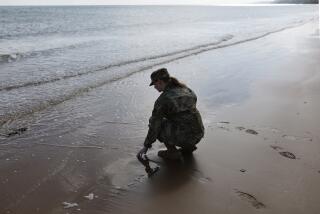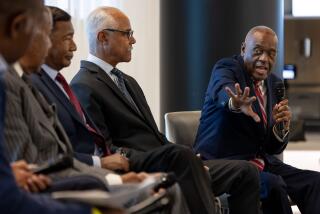Camaraderie Keynotes Devil’s Brigade Reunion
- Share via
HELENA, Mont. — They came from Canada and the United States--385 veterans of the Devil’s Brigade, an elite binational World War II commando force.
They were here in Montana’s capital for the 40th annual reunion of the 1st Special Service Force Assn.
It was Prime Minister Winston Churchill who suggested establishing an all-volunteer strike force of Canadian and American soldiers to attack the Axis powers in critical areas. Gen. George C. Marshall and President Franklin D. Roosevelt agreed, and the U.S.A.-Canada 1st Special Service Force, nicknamed the Devil’s Brigade, was activated on July 20, 1942, at Ft. William Henry Harrison in Helena.
By the time the force was deactivated 2 1/2 years later it had participated in invasions in the Aleutian Islands, at Anzio Beach in Italy, and in southern France. They led the Allied liberation of Rome and wiped out Axis positions on scores of French and Italian mountains.
Of the 2,500 members of this fighting group, immortalized in the film “Devil’s Brigade,” 477 were killed in action and 1,834 were wounded. Of the wounded, 1,500 returned to duty shortly afterward.
Many had been cowboys, trappers, lumberjacks and longshoremen. While training in the mountains of Montana, they slept in snow without blankets to prepare themselves for hardships.
They fought with a vengeance, capturing more than 30,000 prisoners, never failing in a mission. The Germans called them “the devils in baggy pants” because they wore pants with huge pockets.
Wounded Nine Times
Their leader, Maj. Gen. Robert T. Frederick, at 37 the youngest American general at the time, was wounded nine times leading the force into battle. He was the most-wounded general in World War II.
“We were specialists in wiping out enemy strongholds,” said Roy Hudson, 67, a former Canadian soldier, now a naturalized American living in Helena. “We were the first ‘Green Beret’ outfit. We did it all--we were paratroopers, demolition experts, mountaineers, ski troopers and an amphibious landing force.”
Canadian and American veterans of the brigade alternate holding annual reunions in the United States and Canada. This year’s gathering was the seventh in Helena, site of a monument honoring the men of the Devil’s Brigade.
“Every man who served in the force has a special place in his heart for Helena, a city that cast its spell over Americans and Canadians alike when they trained here, a city that continues to hold a special meaning for all of us,” said Bill Story, 65, of Oakton, Va., executive secretary of the 1st Special Service Force Assn.
Canadian and American flags have flown from the monument, a huge granite block in Memorial Park, every day since its dedication Aug. 15, 1947.
“Why did I join the force?” asked Ed Clay, repeating the obvious question.
“It sounded like something a young single soldier ought to do. So, I volunteered like the rest of these fellows.”
Clay, 69, the force adjutant during the war, is manager of the Peninsula Racquet Club in Rancho Palos Verdes. He worked for United Airlines for 42 years and was United’s station manager at Los Angeles International Airport from 1973-80.
“All of us are so intensely proud of this outfit and what it accomplished,” Clay said. “We just didn’t want to let it get away from us after the war was over. We formed lasting bonds of friendship.”
After leaving service the commandos became doctors, lawyers, teachers and businessmen. Some went to work for the Canadian and American governments; many remained in the Canadian or American armies. One hundred of the Canadians became Americans, and a few Americans, like Bill Bennett, 73, of Fort Erie, Ontario, Canada, president of the association last year, became Canadians.
Drawn to Helena
Forty of the men liked Helena so well they made the city their home after the war. This year’s association president, Herb Goodwin, a Canadian captain in the force, returned to Helena in 1946 where he ran a grocery store for many years.
Mark Radcliff, 68, met and married his wife while in training at Helena. He was first president of the association, chaired the force’s first reunion in 1947 and chaired the 40th reunion this year. His granite stone company built the Devil’s Brigade monument.
Jack Akehurst, 76, of Beaverton, Ontario, the ranking Canadian in the Devil’s Brigade, recalled what it was like: “We all wore American uniforms. We ate American food. But each of us wore his own nation’s rank.
“My great-grandfather would never have forgiven me,” he said. “He probably rolled over in his grave the first time I put on that American uniform. His home was burned by Yanks in the War of 1812.”
In the beginning, Akehurst said, “One bunch of us were Canadians, the other bunch Americans. But one night in Helena, when miners started throwing the Canadians out of the Gold Bar, American members of the force came to our rescue and helped throw the miners out of the saloon. Well, from then on we were one.”
According to Lou Merrim, 63, of La Jolla, the brigade’s photographer during the war, “The only difference between the Americans and the Canadians were the accents.”
Ken Wickham, 73, of Los Altos, a lieutenant with the force, made the military a career, became a general and retired as adjutant general of the U.S. Army in 1971. He was one of a dozen members of the Devil’s Brigade who remained in the Army and became a general.
Said Wickham: “The brotherhood between the Americans and Canadians in the force was unbelievable and continues just as strong to this day. When it came time to disband the unit we forgot who was American and who was Canadian. We were all the same.”
Members of the Devil’s Brigade marched briskly through the streets of Helena to their monument in Memorial Park in military cadence, arms swinging. They wore blue berets, blue blazers, gray flannel trousers, white shirts and neckties with the force emblem, a red arrowhead emblazoned “USA-CANADA.”
They were led by a combined American-Canadian Scottish pipe band in kilts, by 89 paratroopers from the U.S. 1st Special Forces from Ft. Lewis, Wash., and 65 paratroopers from Canadian Special Forces based at Pedawawa, Ontario.
The people of Helena lined the parade route, cheering the men of the Devil’s Brigade.
At the monument there was a 21-gun salute. Wreaths were placed in memory of men who died since last year’s reunion at Halifax, Nova Scotia.
The Rev. Herbert Morris, 63, pastor of the United Methodist Church of Canby, Ore., a sergeant with the outfit, read the names of 71 members of the force who had died in the last 12 months.
After the memorial the men were bused to nearby Ft. William Henry Harrison for a pitchfork barbecue and a demonstration by members of today’s Special Forces from both nations.
“This has been the best-attended reunion in our history,” said Richard (Red) Hindle, 71, installed as new president of the veterans association. A retired supervisor of Canadian customs in Montreal, he had driven 2,200 miles from his Quebec home for the gathering.
Hindle was shot and wounded in battle, losing a kidney, injuring his spleen “and like everyone else in the force, I froze my feet,” he laughed. “It’s the esprit de corps of these men, then and now, that has kept us together. We were thrown together as strangers from two different countries and got along so well. . . .”
Ted Martin, 74, of Chula Vista drove to the reunion with his wife Betty. “This is my 20th reunion,” he noted. “It’s a highlight of each year. This is a big part of my life, getting together with my Canadian and American comrades.”
More to Read
Sign up for Essential California
The most important California stories and recommendations in your inbox every morning.
You may occasionally receive promotional content from the Los Angeles Times.













